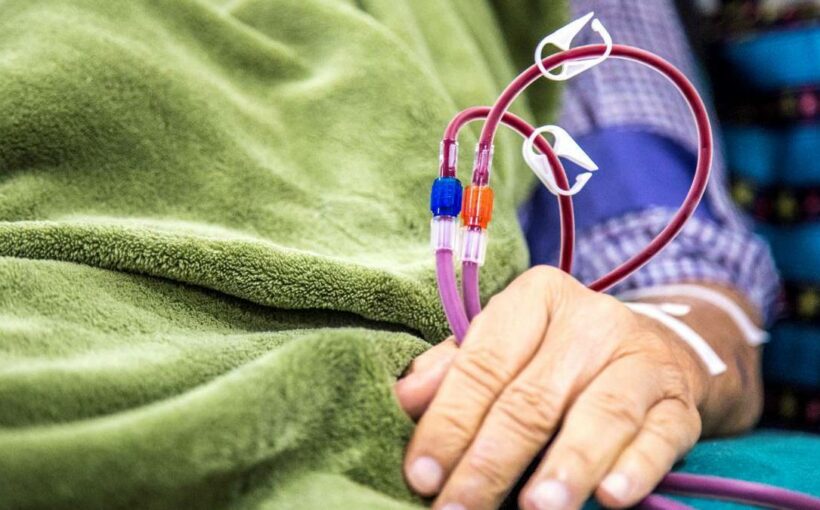Dozens of patients who spend at least 12 hours a week hooked up to a life-saving machine are devastated Greenlane Hospital’s renal unit is closing.
For them it’s a “safe haven” and a lifeline.
Instead, the majority of these dialysis patients say they will have to travel further to Kereru Kidney Centre in Glen Innes – a $7 million Auckland District Health Board 12-year project opening later in the year.
While the DHB says the Greenlane clinical centre is no longer fit for purpose, many patients spoken to by the Herald were heartbroken, with one saying “it sucks, for me time is precious”.
Patients who need dialysis treatment have entered the end stage of kidney disease and nearly all their kidney function is lost.
A letter to the DHB, signed by 35 patients and seen by the Herald, said: “We have no issues with building more dialysis capacity but this is NOT achieving that, at HUGE cost.”
“Greenlane unit needs to be kept operating as it also offers good dialysis plus proximity for the people who rely on its services.”
Auckland DHB Director of adult medical, Barry Snow, told the Herald it was a priority for the DHB that the people in the Auckland central catchment had access to dialysis care that was close to home and in a unit that’s fit for purpose.
“We are replacing the Greenlane Clinical Centre dialysis unit as it is no longer fit for purpose and we have been told by our patients that they wanted their care closer to home.”
The Herald was told by a source the decision to open Kereru Kidney Centre was based on a 2011 survey which showed 25 out of 38 patients lived closer to Glen Innes but that was no longer the case. Now, 10 years later the majority of patients live closer to Greenlane.
When the Herald put this to Snow he said: “We’ve positioned the new unit where there is higher need. Our mapping shows that the majority of Greenlane patients live within a short drive of Glen Innes, and the majority of those who don’t, live within a short drive to Point Chevalier.”
In response to patient concerns about potentially waiting longer due to capacity, Snow said the DHB were not expecting this.
“There will be one patient to one machine on each shift, the time available on each machine will be same and the staff-to-patient ratio will remain the same.”
Patients who used Greenlane would also have the option of using Carrington dialysis unit in Point Chevalier.
Nora van Der Schrieck, chief executive of Kidney Society Auckland, said she really felt for these Greenlane patients because it would affect them the most.
“Some patients won’t get the benefit that others will and I can understand it because my own husband was on dialysis for many years and I know what it means to be shifted around and to have things change when you are doing well the way things are.
“When they move they are likely to come across different staff so it’s a big big change, so I absolutely sympathise with them,” van Der Schrieck said.
But she credited the DHB, saying they had done “a superb job”.
“The project had involved more consultation with patients than I have seen with any other DHB.”
It’s unclear what would happen to the Greenlane unit.
Snow said the DHB understood that a change in location was an adjustment for many patients and they sympathised with them.
“We will be providing support to help them on this transition.”
Meanwhile, dialysis care across New Zealand continues to be a “postcode lottery”.
For example, Whanganui dialysis patients have to travel 75km to Palmerston North at least three times a week to be hooked up to a machine for hours on end.
READ MORE: Inside the life of a dialysis patient
About dialysis in New Zealand
• Dialysis is a treatment that’s used when your kidneys stop working properly, usually due to chronic kidney disease. It cleans your blood by filtering out waste products and fluid that your kidneys would usually get rid of as urine.
• It’s a condition that affects more than 500 New Zealanders, the majority being Māori and Pasifika. For every one New Zealand European or Asian patient starting dialysis, there are about six Pasifika patients and four Māori patients who start dialysis on average.
• There are two types of dialysis, haemodialysis and peritoneal dialysis. Haemodialysis is when your blood is filtered by a machine. The blood is pumped out and then returned, cleansed, to your body. Peritoneal dialysis is when a sugar-based (PD) fluid is put into your abdominal cavity through a tube so your waste products can diffuse into it, after which it is removed.
Source: Read Full Article

/cloudfront-ap-southeast-2.images.arcpublishing.com/nzme/7H665TXIGXN2HIHZ4HIWI4GQW4.jpg)